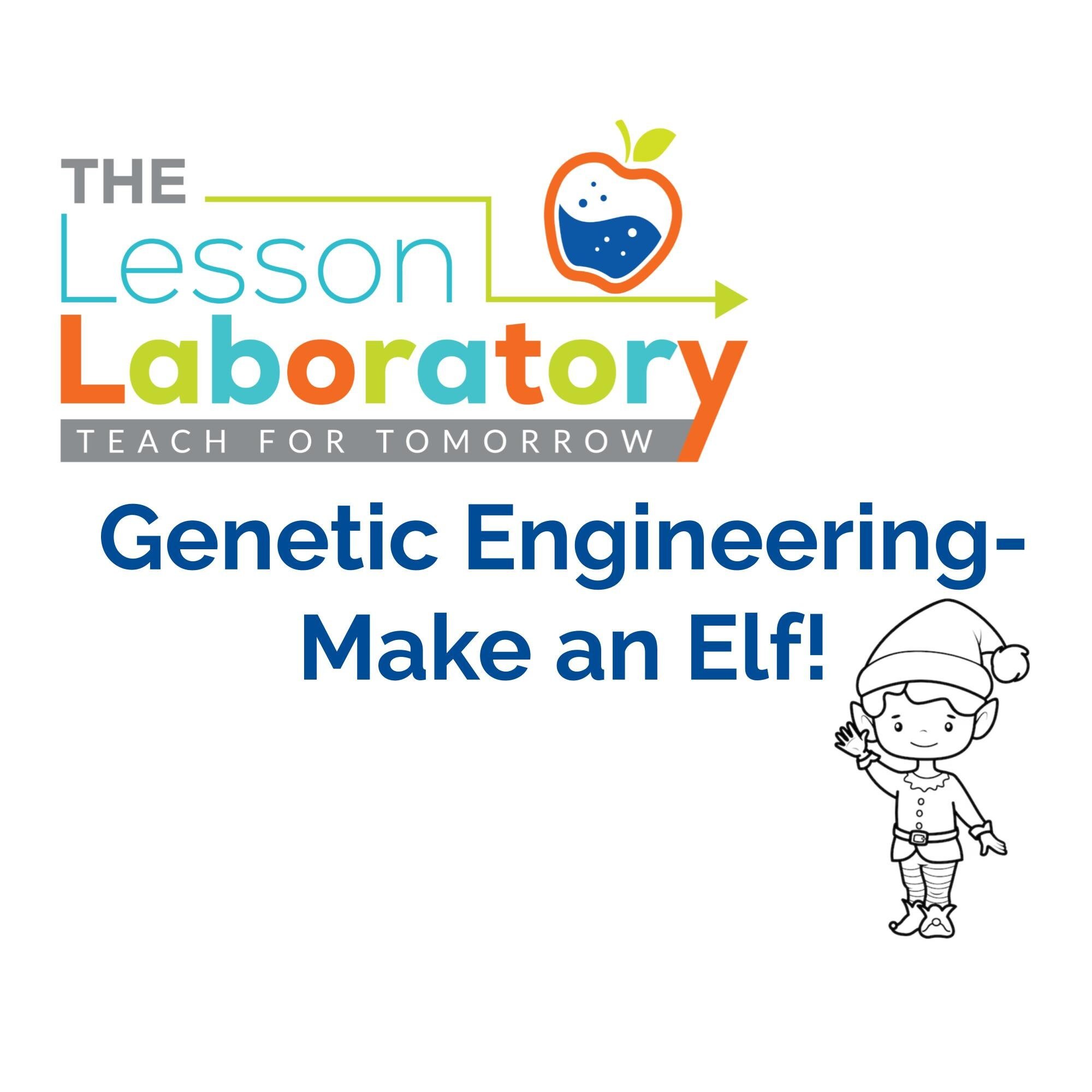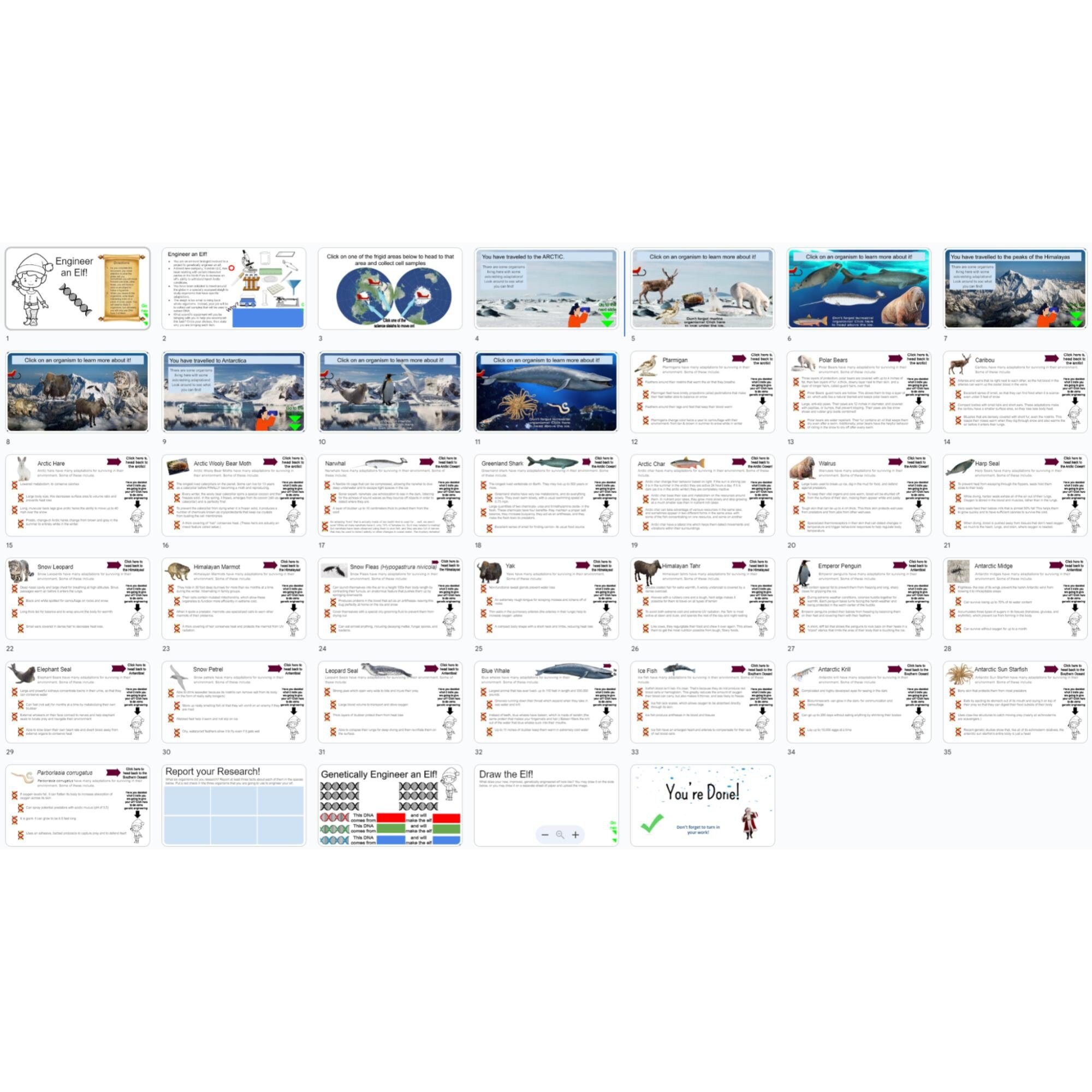 Image 1 of 4
Image 1 of 4

 Image 2 of 4
Image 2 of 4

 Image 3 of 4
Image 3 of 4

 Image 4 of 4
Image 4 of 4





Genetic Engineering- Make an Elf!
Unleash Your Creativity with "Genetic Engineering- Make an Elf" Assignment!
✨Embark on a one-of-a-kind journey into the realm of imagination with our captivating Genetic Engineering- Make an Elf assignment! Elevate your learning experience as you dive into the world of genetic manipulation and design your very own elf, equipped with unique adaptations for survival and style.
Features that Set Us Apart:
Unleash Your Inner Scientist: Delve into the exciting world of genetic engineering as you explore the possibilities of crafting an elf like never before. Our assignment encourages creativity and critical thinking, making learning a magical experience.
Frigid Adventure Theme: Transport your students to the frosty landscapes of the Arctic, the Antarctic, and the Himalayas as they design adaptations to help their genetically engineered elf conquer the cold. It's not just an assignment; it's an immersive journey into science and fantasy.
Hands-On Exploration: Students will actively engage in collecting DNA samples from a wide variety of organisms, sparking their curiosity and enhancing their understanding of genetics in a fun and interactive way.
Seasonal Delight: Infuse the spirit of the season into your classroom! This assignment is a perfect fit for winter, adding a touch of enchantment to your curriculum and making learning an adventure.
Why Wait? Elevate Your Classroom Experience Today!
Transform learning into an enchanting journey of discovery and innovation. Purchase the Genetic Engineering- Make an Elf assignment now and watch your students' creativity come to life!
To preview this product, highlight the link below and paste the address into your web browser.
https://docs.google.com/presentation/d/1sbXhRMI8NDiXXiDjVAQc8nCH7p2JENJNokoipdK5kXI/edit?usp=sharing
Grade & Course Recommendation:
Middle School: Grade 8 honors life science, enrichment for biotechnology topics.
High School: Grade 9–10 Biology, advanced genetics or bioethics lesson.
Cross-Curricular Connections:
ELA Integration: Argumentative writing about ethics in genetic modification.
Art Integration: Creative design element supports engagement and concept retention.
Social Studies Integration: Ties to ethical debates and technological impacts on society.
Daily slide + literacy - based exit ticket included with purchase
Join the Lesson Laboratory and Teach for Tomorrow!
NGSS (Next Generation Science Standards)
HS-LS3-1: Ask questions to clarify relationships about the role of DNA and chromosomes in coding the instructions for characteristic traits passed from parents to offspring. (connection: using knowledge of DNA to “engineer” new combinations of traits)
HS-LS3-2: Make and defend a claim based on evidence that inheritable genetic variations may result from new genetic combinations through meiosis, errors during replication, and/or mutations. (connection: combining traits from different organisms and considering the genetic mechanisms behind them)
HS-LS3-3: Apply concepts of statistics and probability to explain the variation and distribution of expressed traits in a population. (connection: exploring the genetic diversity possible through recombination)
HS-LS4-2: Construct an explanation based on evidence that the process of evolution primarily results from genetic variation and natural selection. (connection: understanding that engineered traits parallel naturally selected adaptations)
HS-ETS1-3: Evaluate a solution to a complex real-world problem based on prioritized criteria and trade-offs. (connection: discussing ethical and practical trade-offs in genetic engineering)
Science & Engineering Practices: Developing and using models; Constructing explanations; Engaging in argument from evidence.
Crosscutting Concepts: Structure and function; Cause and effect; Systems and system models.
Common Core Standards
CCSS.ELA-LITERACY.RST.9-10.1 / RST.11-12.1: Cite specific textual evidence to support analysis of science and technical texts. (connection: using research sources on animal adaptations to support trait selection)
CCSS.ELA-LITERACY.RST.9-10.4 / RST.11-12.4: Determine the meaning of domain-specific words and phrases (e.g., genetic engineering, adaptation, trait, allele).
CCSS.ELA-LITERACY.WHST.9-12.2: Write informative/explanatory texts, including scientific analyses or technical explanations. (connection: describing chosen traits and their genetic basis in the “engineered elf” project)
CCSS.ELA-LITERACY.WHST.9-12.1: Write arguments focused on discipline-specific content. (connection: justifying which traits were selected and why they are beneficial)
CCSS.ELA-LITERACY.SL.9-10.1 / SL.11-12.1: Initiate and participate effectively in collaborative discussions on scientific topics and ethical implications of genetic engineering.
Unleash Your Creativity with "Genetic Engineering- Make an Elf" Assignment!
✨Embark on a one-of-a-kind journey into the realm of imagination with our captivating Genetic Engineering- Make an Elf assignment! Elevate your learning experience as you dive into the world of genetic manipulation and design your very own elf, equipped with unique adaptations for survival and style.
Features that Set Us Apart:
Unleash Your Inner Scientist: Delve into the exciting world of genetic engineering as you explore the possibilities of crafting an elf like never before. Our assignment encourages creativity and critical thinking, making learning a magical experience.
Frigid Adventure Theme: Transport your students to the frosty landscapes of the Arctic, the Antarctic, and the Himalayas as they design adaptations to help their genetically engineered elf conquer the cold. It's not just an assignment; it's an immersive journey into science and fantasy.
Hands-On Exploration: Students will actively engage in collecting DNA samples from a wide variety of organisms, sparking their curiosity and enhancing their understanding of genetics in a fun and interactive way.
Seasonal Delight: Infuse the spirit of the season into your classroom! This assignment is a perfect fit for winter, adding a touch of enchantment to your curriculum and making learning an adventure.
Why Wait? Elevate Your Classroom Experience Today!
Transform learning into an enchanting journey of discovery and innovation. Purchase the Genetic Engineering- Make an Elf assignment now and watch your students' creativity come to life!
To preview this product, highlight the link below and paste the address into your web browser.
https://docs.google.com/presentation/d/1sbXhRMI8NDiXXiDjVAQc8nCH7p2JENJNokoipdK5kXI/edit?usp=sharing
Grade & Course Recommendation:
Middle School: Grade 8 honors life science, enrichment for biotechnology topics.
High School: Grade 9–10 Biology, advanced genetics or bioethics lesson.
Cross-Curricular Connections:
ELA Integration: Argumentative writing about ethics in genetic modification.
Art Integration: Creative design element supports engagement and concept retention.
Social Studies Integration: Ties to ethical debates and technological impacts on society.
Daily slide + literacy - based exit ticket included with purchase
Join the Lesson Laboratory and Teach for Tomorrow!
NGSS (Next Generation Science Standards)
HS-LS3-1: Ask questions to clarify relationships about the role of DNA and chromosomes in coding the instructions for characteristic traits passed from parents to offspring. (connection: using knowledge of DNA to “engineer” new combinations of traits)
HS-LS3-2: Make and defend a claim based on evidence that inheritable genetic variations may result from new genetic combinations through meiosis, errors during replication, and/or mutations. (connection: combining traits from different organisms and considering the genetic mechanisms behind them)
HS-LS3-3: Apply concepts of statistics and probability to explain the variation and distribution of expressed traits in a population. (connection: exploring the genetic diversity possible through recombination)
HS-LS4-2: Construct an explanation based on evidence that the process of evolution primarily results from genetic variation and natural selection. (connection: understanding that engineered traits parallel naturally selected adaptations)
HS-ETS1-3: Evaluate a solution to a complex real-world problem based on prioritized criteria and trade-offs. (connection: discussing ethical and practical trade-offs in genetic engineering)
Science & Engineering Practices: Developing and using models; Constructing explanations; Engaging in argument from evidence.
Crosscutting Concepts: Structure and function; Cause and effect; Systems and system models.
Common Core Standards
CCSS.ELA-LITERACY.RST.9-10.1 / RST.11-12.1: Cite specific textual evidence to support analysis of science and technical texts. (connection: using research sources on animal adaptations to support trait selection)
CCSS.ELA-LITERACY.RST.9-10.4 / RST.11-12.4: Determine the meaning of domain-specific words and phrases (e.g., genetic engineering, adaptation, trait, allele).
CCSS.ELA-LITERACY.WHST.9-12.2: Write informative/explanatory texts, including scientific analyses or technical explanations. (connection: describing chosen traits and their genetic basis in the “engineered elf” project)
CCSS.ELA-LITERACY.WHST.9-12.1: Write arguments focused on discipline-specific content. (connection: justifying which traits were selected and why they are beneficial)
CCSS.ELA-LITERACY.SL.9-10.1 / SL.11-12.1: Initiate and participate effectively in collaborative discussions on scientific topics and ethical implications of genetic engineering.